Keretapi Tanah Melayu Berhad (KTMB) or Malayan Railway Limited, colloquially referred to simply as KTM, is the main rail operator in Peninsular Malaysia. The railway system dates back to the British colonial era, when it was first built to transport tin. Previously known as the Federated Malay States Railways (FMSR) the Malayan Railway Administration (MRA), and the Malayan Railway, Keretapi Tanah Melayu acquired its current name in 1962. The organisation was corporatised in 1992, but remains wholly owned by the Malaysian government.

The North–South Expressway Northern Route is an interstate controlled-access highway running parallel to the northwestern coast of Peninsular Malaysia. The 460-kilometre (290-mile) expressway forms the north section of the North–South Expressway, passing through the northwestern states of Kedah, Penang, Perak and Selangor. The expressway begins at the Bukit Kayu Hitam checkpoint in Kedah, where the Malaysia–Thailand border lies, and ends at Bukit Lanjan in Selangor state where the expressway interchanges with the New Klang Valley Expressway. The expressway is operated by PLUS Expressways.
The Federal Route 1 is the first federal road in Malaysia, the oldest federal road in Malaysia, and among the nation's earliest public roadways ever constructed. The Federal Route 1 was the backbone of the road system in the western states of Peninsular Malaysia before being supplanted by the North–South Expressway.
Malaysian national projects are major national projects that are important to the development of Malaysia. The following is a list from Malaysian independence in 1957 to the present.

The Pan-Borneo Highway including the sections now known as the Pan Borneo Expressway, is a controlled-access highway on Borneo Island, connecting two Malaysian states, Sabah and Sarawak, with Brunei. The length of the entire highway is 2,083 kilometres (1,294 mi) for the Malaysian section, 168 kilometres (104 mi) for the Bruneian section.

Rail transport in Malaysia has evolved significantly since its inception in the late 19th century, reflecting the country's economic growth and modernization.
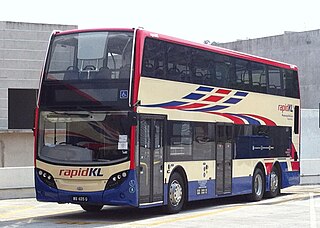
Rapid Bus Sdn Bhd is the largest bus operator in Malaysia operating mainly in urban areas of Klang Valley, Penang & Kuantan. As of February 2023, Rapid KL service brands unit of Rapid Bus, has operates 113 normal routes and also 69 MRT Feeder Bus routes, along with 8 Nadiputra routes in Putrajaya.

Sungai Buloh Highway or Jalan Sungai Buloh, Federal Route 54, is a major highway in Klang Valley region, Selangor state, Malaysia. The highway has now been upgraded into six-lane carriageway on 22 June 2007.

MMC Corporation Berhad is a Malaysian utility and infrastructure conglomerate, with diversified businesses under three divisions: Energy & Utilities, Ports & Logistics, and Engineering. Syed Mokhtar Albukhary is the company's biggest shareholder at 51%, while several government-linked investment companies own over 30%.
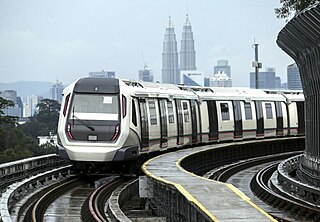
The MRT Kajang Line, previously known as the MRT Sungai Buloh–Kajang Line, is a Mass Rapid Transit (MRT) line servicing the Klang Valley, Malaysia. It is the second fully automated and driverless rail system in the Klang Valley region after the LRT Kelana Jaya Line. Owned by MRT Corp and operated as part of the Rapid KL system by Rapid Rail, it forms part of the Klang Valley Integrated Transit System. The line is numbered 9 and coloured green on official transit maps.
Gamuda Land is the property development arm of Gamuda Berhad, MYX: 5398 an engineering, property and infrastructure company in Malaysia. Established in 1995, Gamuda Land has and is currently developing seven townships in Malaysia and also in Vietnam. The incumbent Chief Executive Officer is Chu Wai Lune, who steers the company since 2023.
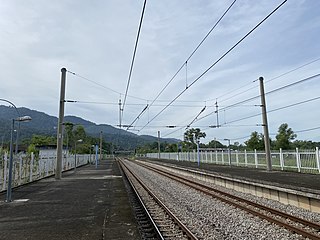
Railway electrification in Malaysia is a relatively recent development of rail transport in Malaysia. While the first railway in the country dates back to 1885, it was not until 3 August 1995 that the first electrified railway service, KTM Komuter, began operations.
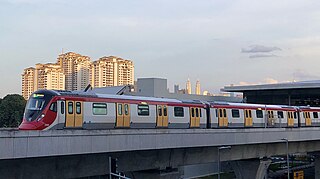
The Klang Valley Mass Rapid Transit project is a planned three-line mass rapid transit (MRT) system in the Klang Valley, an urban conurbation in Malaysia which includes the capital city of Kuala Lumpur. The MRT lines, when completed, would be operated as components of the Klang Valley Integrated Transit System.

Greater Kuala Lumpur is the geographical term that determines the boundaries of metropolitan Kuala Lumpur in Malaysia. Though similar to the term "Klang Valley", there remains a variation between the two. Ranked as the 30th-largest in Asia, it covers a total land size of 13,565.61 km2.

The MRT Putrajaya Line, is the second Mass Rapid Transit (MRT) line in Klang Valley, Malaysia, and the third fully automated and driverless rail system in the country. It was previously known as the MRT Sungai Buloh–Serdang–Putrajaya Line. The line stretches from Kwasa Damansara to Putrajaya and runs through densely populated areas such as Sri Damansara, Kepong, Batu, Jalan Ipoh, Sentul, Kampung Baru, Jalan Tun Razak, KLCC, Tun Razak Exchange, Kuchai Lama, Seri Kembangan and Cyberjaya.

Mass Rapid Transit CorporationSdn Bhd is a Malaysian state-owned company and a corporate body established under the Ministry of Finance (Incorporation) Act 1957. MRT Corp is fully owned by the Minister of Finance (Incorporated).
The East Klang Valley Expressway, EKVEEast Klang Valley Expressway, Kuala Lumpur North Dispersal Expressway or Kuala Lumpur Outer Ring Road(KLORR) is a new expressway under construction in Klang Valley, Malaysia. The 39.5-kilometre-long (24.5 mi) expressway will connect Ukay Perdana in Ampang, Selangor and Bandar Sungai Long in Kajang. This expressway is part of the Kuala Lumpur Outer Ring Road (KLORR). The construction of the expressway was started on 1 September 2015. Once completed, the expressway will benefit 140,000 motorists per day.

The Malaysian Resources Corporation Berhad is a Malaysian construction and property development company based in Kuala Lumpur. It is the master developer of the Kuala Lumpur Sentral transport hub and business district.
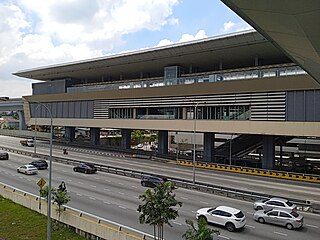
The Sri Raya MRT station is a Mass Rapid Transit (MRT) station serving the suburb of Batu 10 Cheras, Selangor, Malaysia. It serves as one of the stations on Klang Valley Mass Rapid Transit (KVMRT) Kajang line. The station is located at 703 Telekom interchange of the Cheras–Kajang Expressway Cheras–Kajang Expressway.
The following is an alphabetical list of articles related to Selangor.














